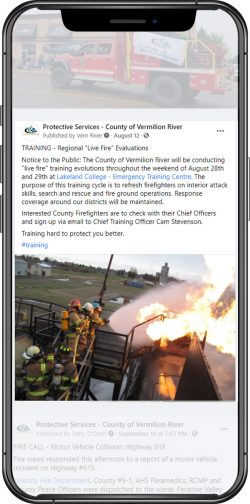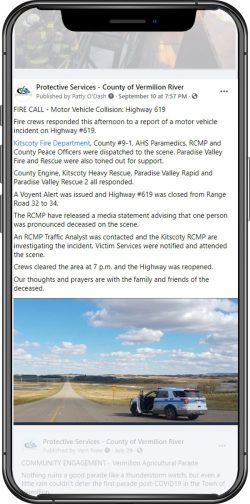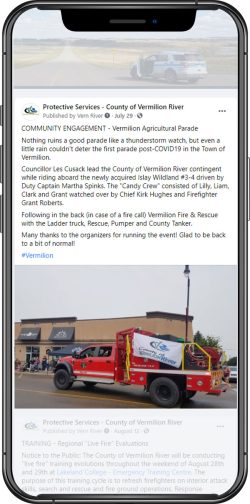
Features
Inside the hall
Social media tips for the times
How to get social media helping you recruit, justify budgets and showcase your level of service
November 4, 2021
By Kirk Hughes
 An effective social media presence requires designating someone to approve, control and monitor the content that will go out on the various platforms.
Photo credit: © bloomicon / Adobe Stock
An effective social media presence requires designating someone to approve, control and monitor the content that will go out on the various platforms.
Photo credit: © bloomicon / Adobe Stock A shrinking volunteer base, tighter budgets and an increased workload have become a constant for many fire stations across Canada. It’s no surprise the cohesion of volunteers has taken a beating. One thing that is often overlooked by fire departments is the increased and effective use of social media platforms to address some of the barriers being faced by the fire service and help to highlight the hard work and dedication that crews display on a regular basis. By reaching a wider audience through subscribers and followers, the fire service receives virtual free publicity and a dedicated medium to share their message.
A successful social media platform is based on a variety of best practices that, if properly used, can create a powerful tool to increase recruiting, justify budget increases and showcase the level of service provided. The following tips are designed to assist a fire service in creating, or revamping, their social media outreach.
The first step is to designate someone to approve, control and monitor the content being added. A single point of contact ensures standardization of the messages being posted, as well as ensures nothing that violates the ethos of a department is added. It is best to have a tech-savvy, highly articulate firefighter assigned to this role. Having a back-up person is advisable in the event that the primary person is unable to manage the platforms (holidays, sickness) as this will prevent the page from going stale. In the fickle world of social media attention span, a page without a steady posting rate often gets relegated to the bottom of a news feed before being un-liked and un-followed. Having designated people allows crews to send photos and content to one source, that can edit and filter out details, ensuring that what is posted is socially acceptable, as well as geared towards a civilian market. Use of “firefighter talk” nomenclature often confuses those without a first responder background, and that stifles the intended target for the post – the public.
Speaking of the public, it is advisable that guidelines are created by executive officers that deal with what is permissible to share and what is considered too sensitive to post. These guidelines should align with any provincial regulations involving information and privacy. Common sense should prevail, so posting of accident scenes with carnage or crumbled vehicles without proper notification of involved families is a recipe for disaster, and unhappy subscribers will comment on the post. The goal is to promote the service, not bring additional headaches. Having flexible but defined guidelines is a preferable way to ensure the message is received appropriately by its intended audience.
Once a designated person has been selected and guiding principles adopted, it’s time to move towards posting criteria. The most common types of posts are often a mixture of informative, educational, and engaging, the core of any good post is the ability to disseminate the message to the reader without overshadowing the message with improper tone, off-putting language or anything that could be perceived as unprofessional. The page represents the service, and it, like the service, is always under scrutiny.
Informative posts are best described as those that highlight the working environment crews are responding to. Posts about structure fires, motor vehicle collisions and noteworthy events fall under this category. The public wants to know why lights and sirens screamed by their house, and they will hunt that information down online in order to satisfy their curiosity. Being the source of that information will make the page popular, while also being able to debunk any misinformation and allow the designated person to control the message, which could be very important in high-risk scenarios like train derailments or large mass casualty events.
Educational postings can include some components of a response, such as a kitchen fire being used as a good example of how to prevent a stove fire, however, standalone messaging has its place. Often an educational post ties in with the themes promoted by the fire service. Fire Prevention Week is a fine example of a good starting point for a “media blitz”, and smoke alarm testing when the clocks change is an old standby. Posting an educational message allows a fire service to bring an issue to the forefront, provide tips on how to mitigate it, and stir up awareness of an important safety topic. In a changing society, this is often the best way to introduce a topic to the public before building on it.
Engaging the public is a by-product of the first two posting criteria, but more can be done to highlight the service and further the reach of a particular cause. Of importance to fire departments are the three issues mentioned in the beginning of this article, summarized as recruiting, budgets and public awareness. Community engagement serves to showcase the work crews do outside of regular responses, or that work which is above the call of duty. These are the “feel good stories” that are often downplayed by firefighters or overlooked by traditional media outlets. Firefighters are traditionally community minded individuals; they don’t shy away from hard work and they do whatever is necessary to get things done. Advertising that work is a key piece to ensuring a captivating page. School events, parades, boot drives, all show the community how vested the fire service is in the places they serve. Use that to raise the profile of the department.
Now that posting criteria has been established, the next step involves the boring part, but be forewarned, failure to adhere to this step will result in posts being overlooked or downright passed by. That step is formatting. Yep, the dull paperwork monster rears its ugly head. A poorly written post, with bad spacing and misspelled words is guaranteed to be forgotten. The public doesn’t share things they have to explain, and they certainly, rarely, share post that make them look foolish. Careless use of wording will, not only sink a post, but it’ll also open the comment section up to lots of corrections, which will devalue the message of the original note and bring criticism to the page. After all, isn’t the purpose of using social media platforms to highlight the service, not undermine it? Here are some formatting tips: Create a simple title for the post. If it’s a fire call, that’s how it’s labelled. Follow it with a brief description of the event, not too much information (privacy rules), and always add a photo to garner interest. Keep the post short and to the point, no one reads lengthy posts. As a general rule, keep it under 200 words. Hashtags are okay at the end and linking to a company website or media outlet for “more information” is acceptable. A good post has a clear start and end line.
Another key factor is the addition of photos and videos to a post. This will draw the interest of the scroller and enhance the likelihood of it being shared, thus generating interest, likes and followers. This increases the reach of the page and allows a fire service to spread their message out to the public. Ideally, the increased attention may generate potential recruits (especially if a post ends with a suggestion to the reader to consider joining) and bring awareness to the valuable work the service does to such people as councillors, administration and most importantly, rate payers. A common comment when a social media platform is well run is, “I didn’t know that the fire department was as busy as it is” or “I can’t believe how much work is involved in being a firefighter”. Those are statements that prove the page is working, that the message is being spread. A good photo, or video, really helps the public “see” what the post is giving context too. A piece of advice: Always depict a firefighter working or a vehicle in action, avoid posting anything controversial, and certainly shy away from posting firefighters without proper gear, doing something not in line with their training or acting in an unprofessional manner. Crews on-scene should be encouraged to capture photos if able and submit them for review to the designated person. That way photos can be reviewed, cropped, or edited prior to posting. Remember, a good sense of humour is important on the internet but be careful on how it is delivered and when. Solid photos and videos explain more than words ever could, so ensuring they represent the service is something to always keep in the forefront.
Once all that has been complete, it’s time for the post to be published. This is where the hard part begins. Every post should be monitored for comments, direct messages or anything that may require interaction between the page and a subscriber. Sometimes, traditional media may contact the page administrator to further a story or get more details. That’s a good thing. Being able to respond to those messages in a suitable time frame reinforces how important the page is to the department, and that customer service is paramount to the page.
Social media is a double-edged sword and requires skilled administrators to ensure the purpose of the page remains on track and the message is delivered. A well-run page will bring in recruits, raise awareness amongst the public and shine a well-deserved spotlight on our firefighters.
Kirk Hughes is the director of Protective Services and the fire chief for the County of Vermilion River in Alberta, Canada. Kirk previously served in the Royal Canadian Mounted Police as well as several fire services across Ontario, Manitoba, the NWT and Alberta. His Facebook page is can be found at Protective Services – County of Vermilion River.
Print this page


